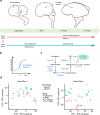Transcriptomic sex differences in early human fetal brain development
- PMID: 40281071
- PMCID: PMC12032161
- DOI: 10.1038/s42003-025-08070-3
Transcriptomic sex differences in early human fetal brain development
Abstract
The influence of sex chromosomes and sex hormones on early human brain development is poorly understood. We therefore undertook transcriptomic analysis of 46,XY and 46,XX human brain cortex samples (n = 64) at four different time points between 7.5 and 17 weeks post conception (wpc), in two independent studies. This developmental period encompasses the onset of testicular testosterone secretion in the 46,XY fetus (8wpc). We show differences in sex chromosome gene expression including X-inactivation genes (XIST, TSIX) in 46,XX samples; core Y chromosome genes (n = 18) in 46,XY samples; and two Y chromosome brain specific genes, PCDH11Y and RP11-424G14.1. PCDH11Y (protocadherin11 Y-linked) regulates excitatory neurons; this gene is unique to humans and is implicated in language development. RP11-424G14.1 is a long non-coding RNA. Fewer differences in sex hormone pathway-related genes are seen. The androgen receptor (AR, NR3C4) shows cortex expression in both sexes, which decreases with age. Global cortical sex hormone effects are not seen, but more localized AR mechanisms may be important with time (e.g., hypothalamus). Taken together, our data suggest that limited but potentially important sex differences occur during early human fetal brain development.
© 2025. The Author(s).
Conflict of interest statement
Competing interests: The authors declare no competing interests.
Figures







References
MeSH terms
Grants and funding
LinkOut - more resources
Full Text Sources
Medical
Research Materials

